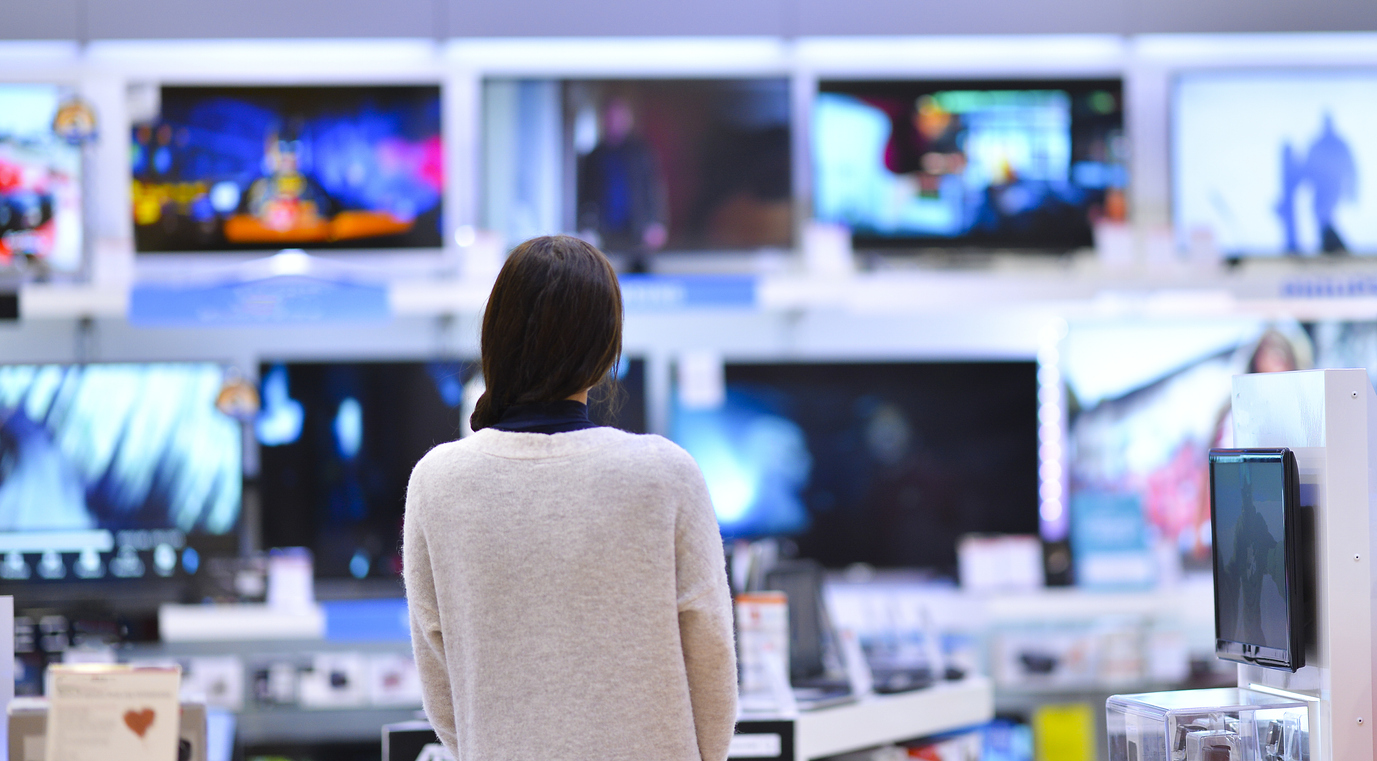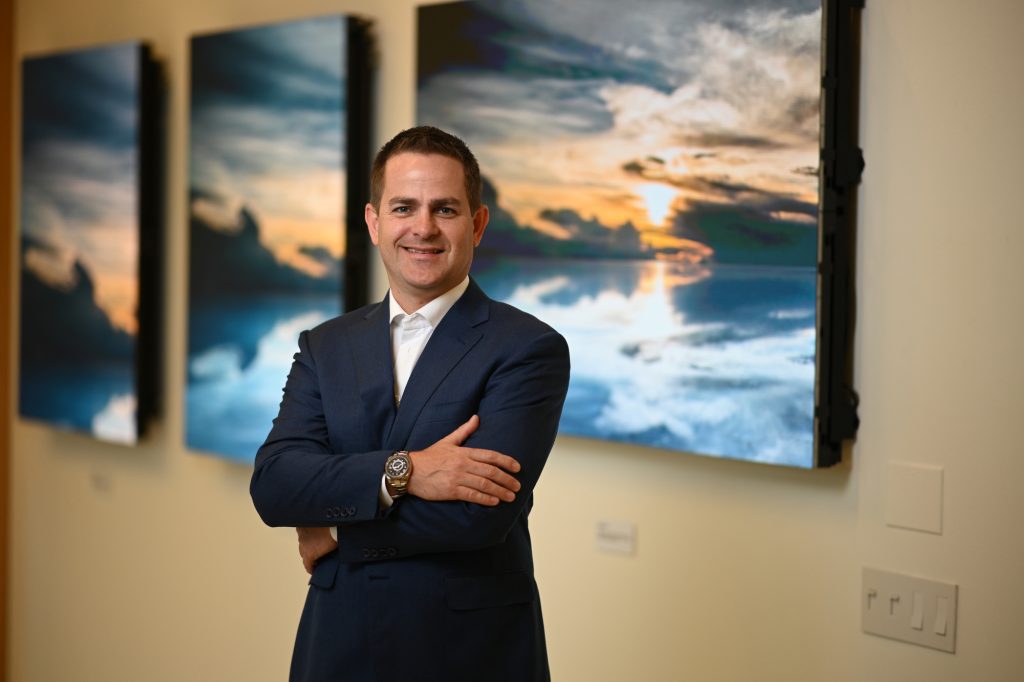Executives from major TV vendors paint a ‘big picture’ of a red-hot consumer market fueled by the pandemic — and the momentum is likely to carry into 2022.
Dealerscope: Large-screen TV sales set records in the pandemic year of 2020, and CTA offered estimates released during early Q1 of 2021 that demand – while it would somewhat abate – would likely remain high for the year, registering the second-highest shipments volume on record. Are your numbers tracking along a similar curve with overall industrywide TV sales? And are price-points holding up – particularly in the strong growth area of ultra-large-screen sets?
David Gold, President, Hisense USA: Hisense achieved a significant milestone last year in having the largest increase in LCD TV market share in North America. We saw tremendous growth, especially in the larger TV size category.
Scott Ramirez, Senior Vice President, Sales & Marketing, KONKA North America: Demand remains very high, across screen sizes. However, our actual sales growth has been constrained by industry supply chain issues, including panel availability and costs, chip issues and shipping costs. KONKA is in the process of analyzing multiple MP (mass production) locations, looking at cost of labor, cost of shipping, local supply chain availability, and more. We are also in discussions with multiple panel vendors to better forecast the quarters ahead. There are some industry share shifts happening that are supply-based. Moving forward, some of these changes may become new trends, while others will revert as the supply stabilizes.
TV retail price points are increasing, possibly for the first time in history. The increases are mostly concentrated in the volume zone where margins were already stressed. The biggest takeaway from this is that consumers are willing to pay a little more for quality, value and timely purchase gratification. As an industry, I don’t believe that we need to continue matching every quality and feature improvement with a corresponding price decrease.
Chris Hamdorf, Senior Vice President of Sales, LG Electronics: XL TV sales are very strong for LG with our OLED77CX TV as the industry’s best selling ultra-premium TV. Consumers who are demanding an XL screen size with unparalleled picture quality are buying LG 77-inch OLED TVs, and we are also about to launch our largest 4K OLED, with an 83-inch addition to our C series. We are looking at extremely strong demand for that screen size as consumers look to replicate a true theater experience in their homes. Our 75-inch-to-86-inch LED TVs are also among the best-selling XL TVs in the industry.
James Fishler, Senior Vice President, Home Entertainment Div., Samsung Electronics America: While industry sales of 75-inch-plus TV sets are up around 20 percent, sales of the same larger screen sizes for Samsung have been significantly higher at 43 percent year to date. Price points are holding up across sizes, but especially in the larger screen sizes, where our ASP in 75-inch-plus is $1,544 (versus $1,522 last year).
John Homlish, Senior Vice President, Skyworth USA Corp.: Skyworth is experiencing high demand for 65-inch-and-larger-screen size TVs. Our top sellers are our 65-inch screen size, and we are also seeing higher demand for the 70-inch-and-above sizes. Our price points are holding up.
Daisuke Kawaguchi, Vice President, Home Entertainment & Sound, Sony Electronics: As you noted, the large-screen-size segments grew more in 2020 than previous years, and Sony has observed this same trend in our sales. Demand increased last year due to the increased time spent staying at home during COVID-19. Shifts in consumer behavior and content consumption this past year have driven strong growth, especially during the holiday season, when the premium segment of $1,000-plus TVs had outpaced total market growth by more than double.
The large-screen-size segment — $1,500-plus — grew even more than other segments, because people have invested in their home environments more due to stay-at-home orders. We expect this trend to last for the next few years.
Chris Larson, Senior Vice President, North America, TCL: We are seeing extremely strong consumer demand for large-screen televisions. Recently, the consumer seems to be seeking better product instead of entry-level in these massive sets. They have discovered what the home entertainment experience can be like with the growth of streaming services and new studio distribution strategy, taking advantage of immersive jumbo screens, QLED, Dolby Vision, etc. The ability to watch whatever you choose whenever you choose it creates the perfect family consumption experience. By embracing the top two streaming platforms with Roku and Google, TCL is confident that the user is finding the content that they want.
TCL is currently launching our “XL collection” to help solve for this demand. A selection of 85-inch screens — with larger sets coming later in the year — with various levels of performance help drive that immersive experience from a theater to a home. The fact that so many first-run movies are being released straight to streaming-only services makes this solution even more attractive. I mean, would you rather drive to the mall, hassle with parking, and buy expensive tickets or concessions to attend a crowded sticky theater — or just head to your family room and enjoy the movie with your family in the comfort of your own home?
Brett Hunt, Senior Vice President, Sales & Marketing, Westinghouse Electronics: Our brand is tracking along this curve, and we have grown our share year over year, due to the demand for Smart TV and our full line of Roku TVs. Our expectation is that the “stay-at-home economy” we have experienced should continue to impact demand, but the consumer will face a reset of higher retails to accommodate the higher core component costs manufacturers are faced with.
David Gold | President, Hisense USA 
Scott Ramirez | Senior Vice President,
Sales & Marketing, KONKA North America
Chris Hamdorf |
Senior Vice President of Sales, LG Electronics
James Fishler | Senior Vice President, Home Entertainment Div., Samsung Electronics America
John Homlish |
Senior Vice President, Skyworth USA Corp
Daisuke Kawaguchi |
Vice President, Home Entertainment & Sound,
Sony Electronics
Chris Larson |
Senior Vice President, North America, TCL
Brett Hunt |
Senior Vice President, Sales & Marketing,
Westinghouse Electronics
Dealerscope: Name one or two feature or technology points about your company’s top TV offerings this year that stand out to consumers right now. What feature sets are most appealing in 2021 to TV purchasers who may just be beginning to emerge from a pandemic mindset?
Ramirez: People don’t really want features, they want benefits. In general, consumers want the benefits of great picture quality and simple, yet robust, connectivity. For the industry, features are simply the technology proof points for these coveted benefits. The KONKA lineup offers a great example of what consumers are looking for, as we target the best possible mix of quality, technology and value, in the volume zone. If we drill down to a few key features, a wide color gamut, with 100 percent-plus of DCI-P3, has become a true quality step that people now understand; that’s why it has become the first real step in most lineups. Whether that is achieved by QLED, OLED, or other technology, it’s the rich picture that people now want. A second key feature is high contrast. Again here, there are multiple technologies being used to achieve this, including OLED, Mini-LED, Local Dimming, HDR and more. However, it’s the dimensional picture depth and overall realism that are truly compelling. A third key feature is a smart platform that provides the top A/V apps, without creating setup or usage pain points, and includes simple and effective voice control. These days, simplicity and convenience are paramount with consumers.
Larson: TCL always develops our sets by first understanding the needs and desires of our users. TCL’s innovation in mini-LED has certainly started a trend in high-performance televisions, as evidenced by competitors who are now following our lead. When you combine this new and exciting backlight technology with quantum dots and HDR technologies like Dolby Vision, we are certainly delivering the color, contrast, and clarity that users aspire to. However, we must be careful to provide solutions for all our users. Some just want the convenience of a delightful and accessible smart experience like we deliver in our 3- and 4-series product. Our goal remains steadfast: to deliver joy and simplicity to our users’ lives via the thoughtful execution of technology. That exact recipe may change from series to series, but it remains our objective across our entire lineup.
Fishler: Picture quality is always important to consumers, and our new NeoQLED lineup offers the premium viewing experiences consumers have come to expect across 4K and 8K lineups. During the pandemic, features that helped simplify the everyday lives of our customers, such as Samsung Health, our TV Plus Streaming platform, and the design-forward features of our Lifestyle TVs grew significantly in adoption and engagement, really expanding the role of TVs in their homes. In 2021, we’ve expanded on those features and enhanced performance in areas such as gaming, making the TV a more integral part of everyday life.
Hunt: Roku TV has been key for us. Consumers want easy access to their content; they want to have access to all content, and Roku has always been one of the first to adopt new streaming content providers. Also, consumers are very familiar with the Roku brand and trust in what they deliver.
Gold: We’re excited to bring our breakthrough Dual Cell technology into living rooms this year. With over two million dimming zones and an impressive dynamic contrast ratio of 2,000,000:1, our U9DG TV is one of the most advanced LED TV technologies in the industry. We also introduced another premium offering from our ULED series line, the U800GR. Our first 8K model features 33 million pixels and four times more depth and clarity than a 4K TV. Customers looking to purchase the latest technology will be impressed with its exceptional picture quality that delivers a stunning entertainment experience.
Kawaguchi: Sony’s new Cognitive Processor XR and BRAVIA CORE service are standout features for our customers this year. Due to an increased demand for best-in-class picture quality and content, these two features ensure customers can experience an incredible cinematic experience in the comfort of their homes. Cognitive Processor XR is revolutionary TV processing technology that understands how humans see and hear to deliver intense contrast with pure blacks, high peak brightness, and natural colors. In collaboration with Sony Pictures Entertainment (SPE), BRAVIA CORE is pre-loaded on all new BRAVIA XR models, so users can enjoy a selection of the latest SPE premium and classic titles and the largest IMAX Enhanced movie collection. BRAVIA CORE is the first in the industry to feature Pure Stream technology, achieving near lossless UHD BD equivalent quality with streaming up to 80 Mbps.
Hamdorf: LG OLED will continue to set the standard in picture quality performance. With our new LG OLED Evo panel, introduced in the LG OLEDG1 series in 2021, we will be providing the consumer with the best picture ever in an LG OLED TV. The LG A9 processor is the best-performing processor in the industry and continues to win awards and recognition from expert reviewers. Our newly designed webOS 6.0 user experience will also provide the easiest way to access a virtually endless variety of content in a quick, intuitive manner. We embedded our LG ThinQ AI system, along with the Google Assistant, Amazon Alexa and Apple Airplay2, which allows for voice search, easy control of the TV and content sharing.
Homlish: Skyworth TVs offer the consumer a tremendous value. All of our 4K UHD TVs feature Bluetooth remote controllers with Voice Command operation; the top models have hands-free control capability. Skyworth’s new 2021 OLED TV lineup offerings deliver on the best picture quality experience for the step-up customers seeking performance, and our opening-price-point series of 4K LCD UHD TVs are fully featured TVs with narrow and bezel-less designs, and a wide viewing angle; all of our TVs for 2021 feature the new Android TV best-of-class Smart TV platform.
Dealerscope: How have consumer stay-at-home behaviors during the pandemic influenced sales of TVs with particular tech features or performance attributes, beyond their just having ultra-large-screens – for example, TVs suited to gaming, TVs with features geared to viewing of very high-quality content, voice control, AI, etc.? And do you expect these influences to continue as influences beyond the duration of COVID?
Larson: Frankly, I don’t think the pandemic changed any behaviors or desires with our product. However, it has pulled up trends that we have believed in for several years. The shift to streaming, which was becoming obvious pre-pandemic, is now a “must-have,” and by supporting both of the key streaming platforms with our Roku and Google relationships, TCL is well-positioned to delight the consumer with their content availability. As more and more content is consumed on these streaming platforms, the experience that can be delivered with 4K resolution and HDR means that our users are able to enjoy best-in-class performance from TCL televisions.
TCL has been focused on the TV’s role in gaming for many years. Our target demographic enjoys gaming as part of their entertainment experience. This is probably a little different than some of the legacy competitors, where their users are older and less interested in change.
Hamdorf: With the arrival of next-gen gaming consoles, gaming on your TV has become an increasingly important feature to many consumers. There is no better gaming TV than an LG OLEDC1. Ranging in screen size from 48 inches to 83 inches, and with advanced gaming features, the LG OLEDC1 has been covered extensively as the best TV for gaming on the market. LG OLED is still the only TV certified as G-Sync-compatible by NVIDIA, and our new Game Optimizer feature on our 2021 TVs gives the gamer complete control to dial in game settings to maximize their enjoyment and gain a competitive edge. As more and more consumers are cutting the cord, the Smart TV user interface becomes increasingly important. LG’s latest version of webOS is available in our new 2021 TVs, giving consumers access to many of the most popular streaming services as well as emerging services tailored to most every interest.
Kawaguchi: Consumer usage behavior has permanently changed. Since customers are spending more time at home, they are willing to invest more in their at-home entertainment. [There are a] few things customers have shown particular interest in.
[One is] high-quality OLED TVs – in Fiscal Year 2020, the OLED segment grew significantly and outpaced other segments in the market. [Another is] streaming – according to Nielsen, consumers in streaming-capable homes in the U.S. now spend 25 percent of their TV time watching streaming video content, and Sony’s new BRAVIA CORE service with Pure Stream technology achieves near-lossless UHD BD equivalent quality with streaming up to 80 Mbps, [allowing] customers to experience great streamed content without compromising picture quality. [Another is] cinema at home – the home has now become an entertainment hub and people want an amazing cinema-like experience in their living room, which our TVs with Cognitive Processor XR make possible – Cognitive Processor XR is in our 4K, OLED and 8K TVs, meaning consumers can get the best home entertainment experience at a range of price points.
[Then there is] next-gen gaming capabilities – key gaming features like 4K 120fps, Variable Refresh Rate (VRR), Auto Low Latency Mode (ALLM) and e-ARC are highly sought by gamers [and] all these features are included in the BRAVIA XR lineup. [And lastly,] an easy-to-use UI – the XR lineup introduced Google TV, a brand-new entertainment experience that brings together movies, shows, live TV and more from apps and subscriptions. [Consumers can] easily find something to watch with personalized recommendations, and bookmark shows and movies to a single Watchlist to keep track of what to watch [and] users can even add to their Watchlist from their phone or laptop, with Google Search.
Hunt: We find that consumers have streamed more content in 4K/HDR than ever before. The pandemic has driven viewing beyond traditional cable- or satellite-based services where there has been limited 4K/HDR programming or channels. This trend will lead to higher expectations from the consumer for high-quality content and a heightened viewing experience.
Fishler: The pandemic may have accelerated the further development of some of our key features. They are indicative of the growing (years-long) demand for TVs that go beyond an exceptional viewing experience – and they’re here to stay.
AI enables performance never before possible — like within our 8K models that can now offer pristine 8K image quality no matter what the original source resolution is, and audio capabilities that bring the theater experience into the home from the TV itself. Samsung Health and — new for 2021— Smart Trainer offered a comprehensive fitness and wellness platform across TV and mobile at a time when working out at home had become more important than ever before. Smart Trainer leverages an optional USB camera to provide real-time feedback on form, posture and rep counts to further expand on the in-home fitness capabilities.
Simplified Video Chats & Conferencing, including our partnership with Google Duo, make keeping in touch with family and friends, no matter where they are, something that consumers have embraced. And our Remote Access Plus feature enhances productivity and connectivity between personal and professional life from the convenience of the TV screen.
With our Free Samsung TV Plus service, consumers have access to a large library of content at their fingertips, with over 160 channels, all without a subscription. Game Bar, for those passionate about their gaming performance, takes the TV to the next level with capabilities on par with the best gaming monitors. [And] our Multi View capability lets the viewer watch four different sources at once. Imagine being able to experience your game, and follow along with video and even a video conference with your teammates all at the same time….
Gold: The gaming industry has seen a tremendous boom over the last few years but saw record sales in 2020 with the release of the new next-gen consoles. Our 2021 lineup includes added features like Ultra High-Speed HDMI, VRR, ALLM and FreeSync Premium to give consumers the ultimate gaming experience. For consumers adjusting to the work-from-home routine, Far Field voice recognition was integrated into our new lineup so people can easily control their TVs without touching their remote. We also noticed the continued rising trend in larger screen sizes. Especially being at home more than usual over the last year, consumers were looking for bigger screens and more of a home-theater experience. This year, we have 75- and 85-inch options as well as a 120-inch Laser Cinema for an impressive viewing experience.
Ramirez: The two key standouts here are great A/V streaming and quality gaming. For streaming, this means simple operation with fast and easy content discovery and high-quality playback. For gaming, this means faster response times, and even variable refresh rates, to reduce or eliminate input lag. While the demand for these performance attributes was certainly increased by the necessary stay-at-home lifestyle we have all been enduring, such demand existed before COVID, and will only grow as we move forward.
Homlish: The demand for all sizes of TVs was experienced in 2021. Depending on the application, there were smaller sizes that doubled as computer and game monitors; larger sizes are 4K UHD that offer great picture quality, common these days. Important features are robust Wi-Fi connectivity required for video conferencing and cloud gaming. We expect features that support better video and gaming experience with features like VRR (variable refresh rate), ALLC (auto low latency control), and 120Hz. We also see a trend to more affordable high-performance picture quality that plays into our new OLED TV line for 2021. As mentioned earlier, our technology partner for Smart TV is Google, and we are very excited that all of our 4K UHD TVs feature Google Assistant, works with Alexa, and hands-free operation that consumers will grow to enjoy more and more.
Dealerscope: What are (or what will be) the operative “feature buzzwords” in the-large-screen TV sector, moving into the second half of 2021?
Hamdorf: The main buzzword is “immersiveness.” It’s all about bringing the movie theater experience, the ultimate gaming experience or the live sports experience into the home in a way that immerses you in it. A big-screen LG OLED delivers that experience with superior picture quality and audio features like Dolby Atmos.
Ramirez: Number One: consistent availability — while not technically a feature, it will remain a key factor. Number Two: big screen — as 55- and 65-inch become mainstream, 75-, 82- and 85-/86-inch become the new aspirational big-screen sizes. Number Three: OLED, QLED, & Mini-LED — and possibly some other new terms that include LED. These are important as they are panel technology innovations that justify a new purchase. Number Four: everything else new (8K, AI, Dynamic HDR, VRR, HDMI 2.1, ATSC 3.0, etc.).
Fishler: We will be hearing a lot about AI in 2021, as consumers experience 8K without the traditional need for native content. In the past, as examples, viewers needed 1080p or 4K content to enjoy the new resolution capabilities. AI has made it possible for consumers to get the improved resolution, without having to purchase a title in the new format. Of course, as the content industry develops content in native 8K, the TVs will be ready to deliver the ultimate viewing experience.
Beyond the picture, we will also see more and more of what we call the Lifestyle TV category. Our new series of outdoor TVs, called The Terrace, have taken the performance of our premium indoor models to the outside of the home, perfect as we enter barbecue season and people can come together again. The Frame continues to appeal to more and more homeowners for whom how the TV blends into their décor is just as important as how the picture looks. The Premiere is the perfect solution for bringing the full cinematic experience home in a way that doesn’t require the “real estate” more traditional projectors needed. These types of TV go far beyond what we are used to in the industry. It’s no longer about “feature sets” from series to series, but rather models that offer consumers the ability to really personalize what they experience from their TV.
Gold: We anticipate a lot of discussion around 8K. With screen sizes getting even larger, it will also be interesting to see how laser TV and short-throw projectors will begin to competitively play in the space and become a more popular alternative to LED TVs.
Homlish: Slim design and bezel-less screens for cosmetics, Dolby Vision and Atmos for picture quality and audio quality performance, and AI control solutions like Google Assistant.
Dealerscope: Have display panel pricing increases had an impact as yet at the consumer level? Do you expect them to – and if so, when?
Hunt: Core component costs have increased every month since May 2020 and it has taken till the last few months to show up at the consumer level.
Particularly, you can see this fact with 32-inch Smart TV retail pricing, as this was one of the first sizes that had production constraints. Retail prices for this size have increased almost $30, and there is potential to increase to price points over $200 retail by the end of Q3. TV merchants are carefully managing this trend and are keeping a close eye on their retail peers as they build their business strategies. There is also another aspect that still needs to play out this Fall; component shortages that are affecting all industries will play a role in supply and pricing. With the component shortages, we see resources being focused on larger screen sizes with premium picture technology.
Ramirez: Yes, they have, and changes may continue throughout the summer. The industry could return to stability in the fall, but that is not yet certain.
Larson: We have watched component prices move up at a record pace. Shortages of glass and semiconductors have driven constrained supply availability and pricing on finished goods to increase. We do not expect these moderate price increases to have significant effect on demand as there are still few options to deliver comparable value to an LCD television today. The capabilities and performance of these sets still clearly portray maximum entertainment value. You can get seven to 10 years of joy for your family through the purchase of a 75-inch TV with the same budget you would spend on an overnight stay at a theme park!
Gold: We have already seen an impact on the consumer level and anticipate it will continue.
Homlish: To date, I don’t believe increased panel pricing has had an impact at the consumer level; however, I would expect the impact to occur later in Q3/Q4.
Dealerscope: How are you adjusting your marketing supports to aid retailers in accommodating the “new normal” of the sales process, which has moved in the past year more and more to online as opposed to in-store? What are you doing to help dealers more effectively make the case for your TV brand and your technologies in a virtual format?
Ramirez: With the move to more online sales, now and in the future, it is necessary to increase and improve digital assets. This can and will take the form of lifestyle images, 360-degree images, lifestyle videos, product videos, infographics, and much more.
Larson: Due to our demographic, TCL has always been a digital-first company in terms of marketing and presentation. Despite the fact that most TVs are still purchased in a brick-and-mortar store, the research begins online. As a relatively new brand, it is our focus to be in the consideration cycle when that consumer decides they want to purchase a new TV, and that task is best accomplished digitally. At the end of the day, we want the consumer to purchase from the retailer they feel most comfortable with, but our role is to ensure that the choice is to consider a TCL television from that retailer.
Homlish: 2020 was a year of realization that video telecommunications can address many business challenges we faced during the stay-at-home / work-at-home realities. Meetings with our customers, virtual sales training, and consumer product support videos that can be downloaded or streamed online. We are investing in offering pre- and post-sales support tools via our new website that will support and service the consumer, our business partners, and elevate the Skyworth brand in the North American marketplace.
Hunt: In 2020, retailers needed to focus on their online engagement with consumers. Either pick-up-at-store or online fulfillment have been perfected out of necessity, due to state restrictions. We have worked hard to create enhanced content, manage consumer reviews and build our brand online with all of our partners. Though the economy is now opening back up, our focus will continue to grow our brand online with our retail partners.
Fishler: In 2021, we’ve invested heavily in product and brand assets that are available to all of our retail partners, which will allow for improved digital engagement with consumers on their sites, as well as omni solutions that better connect online and offline retail experiences in store and across their digital properties.
Dealerscope: Thinking far down the retail road, what points of focus will you concentrate on in striving to communicate your TV lines’ technologies and advantages to consumers after the COVID situation resolves?
Ramirez: We need to evolve as the world evolves. The future will necessitate a mix of old-school message reinforcement for those at the last three feet, a more personal approach to digital messaging for the consumer, leveraging social media and peer-to-peer evangelism, and being creative to develop new, fun ways to gain exposure while adding value.
Fishler: During the pandemic, Samsung developed a contactless interactive option for consumers that preferred not to touch displays at retail. The consumer would scan a QR code that enabled them to select content choices using their personal device and interact with the display. The functionality was the same as if they touched the interactive buttons on the display. [It was] an innovative solution that addressed the needs of the time.
As we look ahead, our new digital/ecommerce world is here to stay. We will continue to innovate further to drive even more consumer-centric engagement and interactivity with our products online, and to provide omnichannel exploration, shopping, purchase, and delivery solutions for more seamless, convenient and delightful consumer experiences with our brand.
Homlish: Skyworth will be investing more on digital marketing in further developing the brand in this important marketplace, and simultaneously investing resources in developing and reaching the customers of our retail and online distribution partners. The behavioral paradigm that evolved through the last year was more dependent on online resources, and we see this playing a larger part in a consumer’s purchase journey.
Dealerscope: What do you think will be the biggest challenge affecting major TV vendors such as yourself – and what will be the biggest opportunity – in the post-pandemic period, assuming that that period will be in 2022?
Hamdorf: Supply continues to be a major issue in 2021. But with that challenge is a great opportunity for LG. One hundred percent of the OLED panels in LG TVs come from LGD. The partnership with LGD has created a much more reliable supply of LG OLED TVs in the market vs. competitive-brand LED TVs. We are confident that we can supply LG OLED TVs in 2021 to meet the rapidly growing demand.
Hunt: Clearly, everybody is focused on how the higher prices in the market will affect sell-through. The market is being reset for the first time in more than a decade, so it is a bit of new ground. Consumer prices are rising for goods and services at a rate that we have not seen since 2008. We have to be very focused on supporting our retail partners until there is more stability.
Fishler: The biggest opportunity will be on how the consumer “views” the TV itself. What was previously seen as a device that let viewers enjoy their favorite programs and movies, then grew into an on-demand streaming device, has now become a larger part of everyday life. Having experienced what’s possible, consumers will look to TV manufacturers to expand on products, features, and capabilities that speak to their passions — whether that’s entertainment, fitness, gaming or even art. What was previously a “nice to have” is likely to become more of a “need” from their TV. Samsung has always focused on the experience; we see a very bright future in what’s possible, and look forward to delivering those experiences to our customers.
Larson: With the consolidation of panel suppliers and some key TV brands exiting the panel business, there is tremendous opportunity for TCL to use our vertical integration to continue to grow our market share. We will be the only major brand in the USA that has the resources of a top panel supplier while others will be forced to purchase panels from TCL CSOT, or one of their competitors. This vertical integration provides extraordinary advantages in terms of speed of product iteration. Take mini-LED, as an example — TCL was able to lead this technology by YEARS simply by having a vertically integrated supply chain that can move faster than our peers.
As a student of our industry looking at history, I think we can see that brands come and brands go based on their ability to survive these industry changes. We are very fortunate that TCL has made significant investments to not only pull us through but also to make us stronger in this new environment.
Gold: Within the TV industry, supply is still the biggest challenge. However, we anticipate it will also be the biggest opportunity, post-pandemic.
Homlish: Retaining customer loyalty. Consumers were more dependent than ever on their “TV devices” this past year, as the vital window to the world. Service support for all industries has been a challenge since everything is done online and via phone calls. Skyworth has integrated our call center and the service center support, and we believe this alleviates the need for “handoff” to “another department” when a consumer is looking for answers.
Ramirez: Supply chain will remain the biggest challenge throughout 2021 and beyond. Although TV is not a commodity, the volume zone is very price-competitive. So, ensuring a consistent supply chain and reducing logistics costs becomes a necessity for survival and growth. Regarding the biggest opportunity, this will be a rare moment in time where both vendors and retailers can reimagine and transform themselves relatively quickly. Creative companies can better target and touch the new consumer, and improve their brand position faster than what would otherwise have been possible.
Dealerscope: Do you have any additional insights or predictions you can offer CE retailers (not already touched upon) about what to expect in TV sales for the balance of the year?
Ramirez: Specifically, I would suggest more focused retail spaces, technology-based demos, and website enhancements to help create simple, yet informed purchase decisions. In short, make it easy for consumers that want to make a smart choice.
Fishler: As consumers have made, and continue to make, their homes more comfortable and more personal, they will be looking for TVs that are not just the traditionally designed “screens,” but TVs that fit into their new lifestyles — TVs like The Frame, that blend into their space, become a statement in that space, like the Serif, bring the cinematic experience home, like our Premier projector, or even take the entertainment experience outdoors, like our Terrace TV. The TV, and what it means to the consumer, has changed.
Added to that, we see accessibility and sustainability as core values that are more prevalent in our products this year and will manifest themselves even more in our products in the future, taking on a larger role in capabilities and how we launch our products. For the retailer, this means selling beyond picture quality and content to more personalized, lifestyle and sustainable considerations.
Homlish: For Skyworth, we’re looking to expand our dealer base with affordable, high-quality TVs, and we are seeing signs that our brand will fill several anticipated “gaps” between now and the end of the year.
SUMMARY:
• The pandemic provided the impetus among consumers not only for buying larger-screen TVs but also for desiring more fully featured models – and they are willing to pay higher prices for additional levels of functionality, including streaming capability and cutting-edge technologies related to heightening the gaming experience.
• While the stay-at home economy has positively impacted TV sales, manufacturers are faced with higher core component costs, and with glass and semiconductor shortages which have somewhat constrained supply availability. Retailers are carefully monitoring these trends and strategizing on how they will play a role in pricing.
• All vendors are focused on providing their retail partners with brand assets that will make it easier for dealers to engage on their websites with their customers about various TV brands’ attributes.

Nancy is a contributing editor for Dealerscope.






















